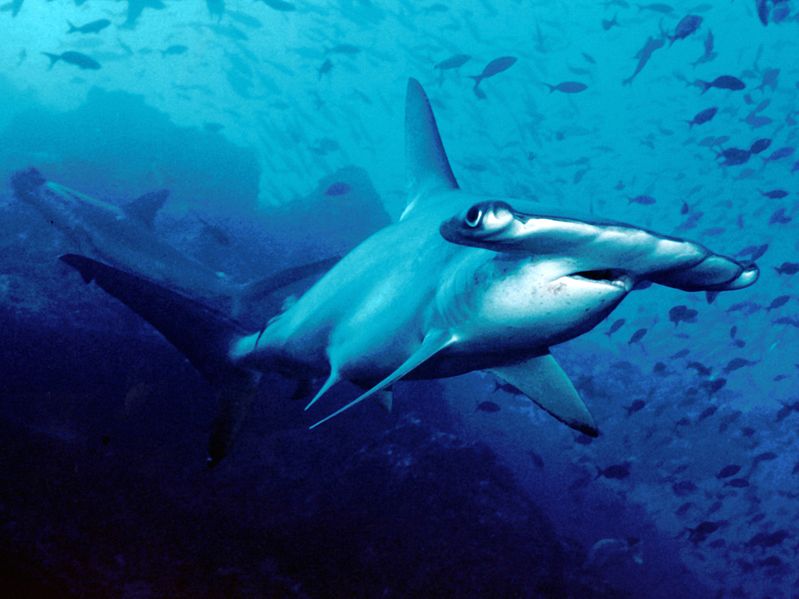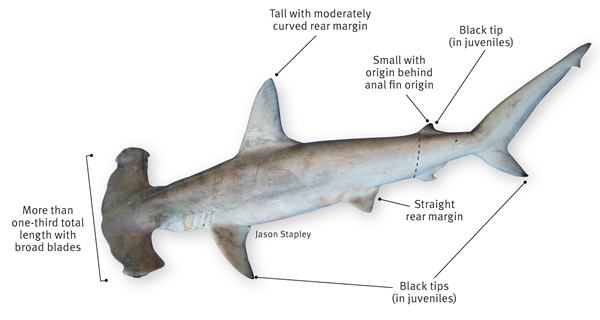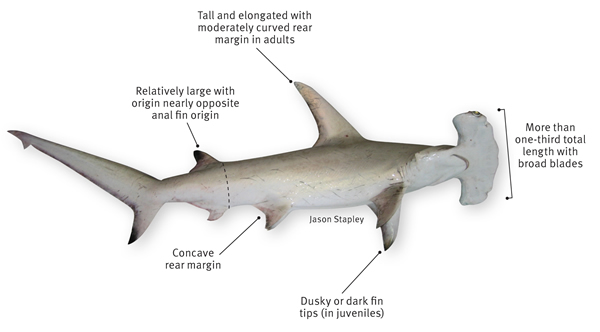
Scalloped Hammerhead is a coastal-pelagic, semi-oceanic shark that circumglobally residing warm coasts and tropical seas. It is a nocturnal predator that can grow up to 4.3m and 152.4kg. Scalloped hammerheads are usually active at the depth of 0 to 25m, but they can dive at least 275m deep. Adult scalloped hammerhead usually live in pairs or small groups , while juveniles gather in large schools [1]. Scalloped hammerhead plays an important ecological role due to its wide distribution, acting as the apex predator, parasite host, symbiotic partner, and even scavenger. Being economically valuable, it now faces the threat of over-fishing, aquatic pollution, and shark fin trading. Scalloped hammerhead is now in the red list of IUCN as an endangered species.
Table of Contents
Etymology
Scientific Names
Scalloped hammerhead was first described by Griffith and Smith as Zygaena lewini in 1834, then renamed as Sphyrna lewini (Griffith and Smith, 1834) and remained using this name. In Greek, the word Sphyrna means hammer, which describes the most unique feature of hammerheads, the hammer-shaped head. Other names that have been used for scalloped hammerhead in literature include Cestracion leeuwenii (Day 1865), Zygaena erythraea (Klunzinger 1871), Cestracion oceanica (Garman 1913), and Sphyrna diplana (Springer 1941).Geographic Distribution
Habitats
Scalloped hammerhead is one of the most widely distributed shark species. Being able to survive from inshore estuarine to offshore depth of 512m,World Distribution Map of Scalloped Hammerhead
Anatomy
Hammerhead Sharks
Comparison of hammerhead sharks:
A. smooth hammerhead, B. scalloped hammerhead, C. great hammerhead, D. bonnethead
© George Burgess
The most obvious character that can differentiate these four Sphrna species is the shape of their heads.
Despite the similarities between the four species above, scalloped hammerhead is known to be smaller than great hammerhead or smooth hammerhead.
Scalloped Hammerhead


Biology
Feeding
Reproduction
Growth
Ecology
Ecological StatusHuman Uses
Scalloped hammerheads are sought mainly for their meat, hides and fins. Their meat serves as great fishmeal after smoked or dried. Their hides can be processed into various ornament or industrious materials. Their shark oil can be made into vitamin supply products. Like many other shark species, fully grown scalloped hammerheads possess large and valuable fins that are regarded as a rare delicacy throughout the world.Conservation
In 2008, scalloped hammerhead was added to Globally Endangered Species List, together with other 8 shark species. There are more than 200 shark species in the World Conservation Union (IUCN), and more than 10 of them are under 'Critically Endangered' status. The catch data of scalloped hammerhead and Sphyrna spp. overall induced a decline in their abundance of more than 50% in the past 38 years at many of their habitats. For U.S. east coast, the decline had even reached 98% in 2007. The pelagic longline fishing fleets at eastern Atlantic reported that the catch of adult scalloped hammerhead became rare, and the catches in some areas only consisted of juveniles.According to the discussion in American Association for the Advancement of Science (AAAS), excessive fishing and an increasing demand for shark fins are the major reasons for the population decline of scalloped hammerhead.